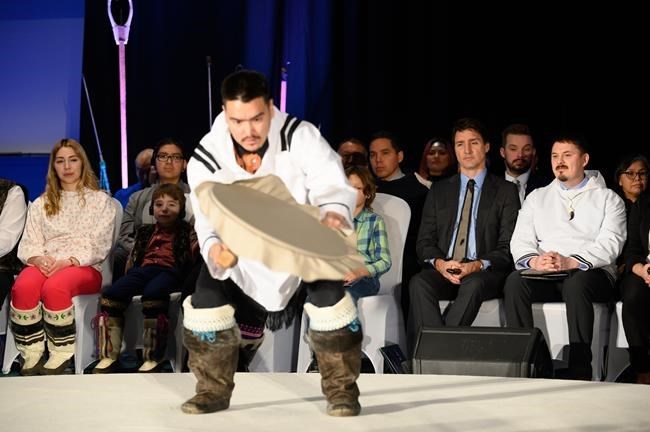IQALUIT, Nunavut — As a child growing up in Canada's northernmost community, P. J. Akeeagok wanted to be a water truck driver.Â
In Grise Fiord, an community on Nunavut's Ellesmere Island where just 145 people live as of the 2021 census, the water truck driver served as a role model who delivered an essential public service.Â
Akeeagok's public-service instincts led him in a different direction: the 39-year-old is now the country's youngest premier, leading the federation's youngest territory.Â
And on Thursday, he inked his name to an agreement with the federal government on that he hopes will open up more opportunities for coming generations.Â
Akeeagok and Prime Minister Justin Trudeau, along with other signatories, finalized on Thursday what is formally called the "Nunavut Lands and Resources Devolution Agreement."Â
Simply put, the agreement transfers powers over public lands, waters and the non-renewable resources each contain to the territory and — more importantly — away from the federal government.Â
The Northwest Territories and Yukon went through similar processes, known formally as devolution, years ago.
Sitting in his office for an interview the day before the official ceremony, which included performances by Inuit drummers and throat singers, Akeeagok said Nunavut's signing signifies the start of an exciting few years.Â
Its residents, most of whom are Inuit, will become the decision-makers over their own physical territory.
"What better stewards than the people who call Nunavut home," he said Wednesday.Â
One thing the agreement will signal, he said, is the creation of new jobs. It also opens the door to Nunavut gaining new sources of revenue, such as those from resource development.Â
It's the largest land transfer in Canadian history. Nunavut makes up one-fifth of the country's land mass.Â
Speaking before Thursday's signing, Trudeau said the transfer amounts to two million square kilometres of land, a fact he referred to as he and other signatories sat for minutes signing a slew of documents comprising the actual agreement.Â
Parties to the deal have given themselves until April 2027 to sort out remaining complexities, such as transferring over human resources and federal buildings, like one Akeeagok points to from out his office window.Â
Thursday's celebrations marked the end of a long road to arrive at a final agreement.Â
Nunavut was created as its own territory, separate from the Northwest Territories, in 1999.Â
In 2008, it entered the process of gaining control over its lands and resources by signing a negotiation protocol with former prime minister Stephen Harper's Conservative government.Â
Harper appointed negotiators ad the process eventually culminated in a 2019 deal between Nunavut, Canada and Nunavut Tunngavik Inc., which represents Inuit treaty rights.Â
That year, Trudeau's then-Crown-Indigenous relations minister, Carolyn Bennett, signed an agreement-in-principle with Nunavut's then-premier intended to serve as a guide for negotiating a final agreement.Â
Akeeagok, who before being elected premier in 2021 presided over the Qikiqtani Inuit Association, said it feels "surreal" to ink his name to the document.Â
He told the crowd of Inuit leaders gathered from across the territory and Ottawa on Thursday that the agreement signals the start of Nunavut managing its own natural resources, including lands that are "rich with minerals."Â
During his speech, Akeeagok reflected on how his remote upbringing was a testament to Inuit resilience and said that young people from across the territory should know they have a future.Â
The day before, seated in his office, he pointed to the inspiration his family provided him throughout his life and career, their faces captured in photographs from his swearing-in ceremony mounted on his office wall.
He recently shared his childhood dream of driving a water truck with kids he visited at schools in communities such as Whale Cove and Chesterfield Inlet, both of which have populations of around 440.Â
They shared their dreams, too.Â
Some wanted to be conservation officers. Others said they'd like to be electricians, a career they can pursue by attending a trade school in Rankin Inlet.Â
"It was really fascinating to hear that sense of pride," the premier said.Â
"When you start opening up these kind of opportunities, like the devolution agreement, you really open up a lot more opportunities for these youth that otherwise wasn't there, so that's what I always end up thinking about."Â
As he heads into work each day, Akeeagok said he asks himself: "How can we make Nunavut better?"Â
Everyone knows the territory has challenges, he said.Â
It has some of the country's highest suicide rates. A lack of housing has led to decades of overcrowding, which has created poorer health outcomes. There's also the high cost of living, which keeps on rising.Â
In its capital, Iqaluit Mayor Solomon Awa says it's not possible to expand the footprint for where new homes can be built without first fixing a water crisis. The current reservoir is too small to support a growing population.Â
Addictions and alcoholism are other social issues the mayor said he hears about.Â
He said in an interview that he hopes with the building of the territory's first treatment centre in Iqaluit, residents will see that they have somewhere to go that is not Ottawa, Toronto or Winnipeg.Â
"With the Inuit staff, hopefully ... more people will start opening up that they need some help," he said Wednesday.Â
Despite all the challenges, Akeeagok said there are also lots of opportunities.Â
"How we seize those opportunities is what we need to put our energy and focus to, and this devolution agreement, I think, points us to that direction."Â
This report by The Canadian Press was first published Jan. 18, 2024.Â
Stephanie Taylor, The Canadian Press




